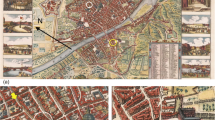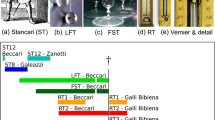Abstract
Having been in use at Hohenpeissenberg from 1781–1841, the Palatina thermometer was found to suffer from a positive bias of 0.5°R (or 0.63°C) as discovered by Lamont following a re-calibration made in 1842. The main reason was due to the composition of the glass used during the early instrumental period. Glass of this period tended to contract over many years due to thermal aftereffects, resulting in a gradual rise of the freezing point position in consequence of the shrinking bulb forming the mercury reservoir. While the problem of the gradually rising zero point was recognised relatively early, the reason was attributed to wrong causes. Around 1880, scientists recognised that the chemical composition of glass might be responsible for the drift of the zero point. New glass types were developed which were free from such effects. Although these facts became known, no correction was applied to the Hohenpeissenberg temperature series when in 1981, the complete 200-year series was published. Most probably this bias is also relevant for other stations, at least those of the network of the Societas Meteorologica Palatina that were supplied with thermometers manufactured in Mannheim. Another problem originates from the different observing times for the period 1879–1900, which were set to 0800, 1400 and 2000 hours instead of 0700, 1400 and 2100 hours before and afterwards. In addition, a new formula to calculate the daily mean was established resulting in the temperature being too low by 0.5°C in that period. The overall trend changes after application of the two necessary corrections. There remain two biases that cannot be quantified without a major detailed study being made: (1) At the start of the observations, the window of the observation room was always kept “open during dry weather”. It is not known how long this practice was remained in use. (2) Lamont also employed an easily melting glass to construct his thermometers which in use between 1841 and 1878. An analysis of the glass composition seems to be necessary to find out whether it also suffered from a rising freezing point. Lamont replaced the Hohenpeissenberg thermometer in 1842 by a new instrument produced in his own workshop. One still existing Lamont thermometer, but not that one of Hohenpeissenberg, was re-calibrated and the zero point found to have lowered by −1.4°C. Since the opposite drift had been expected and the original Lamont-type Hohenpeissenberg thermometer is no longer available, no correction is justified for the period in which this thermometer was in use.





Similar content being viewed by others
Notes
Manufacturer of the clock was Gegenreiner from Augsburg.
Handwritten report in Bayerisches Hauptstaatsarchiv, MK 40453, fol. ad 22.
Archive of the Academy of Sciences Munich: VIII 163a, fol. 160–162.
Bayerische Hauptstaatsarchiv: MK40453.
Lamont’s letter from 8 January 1843, Archive of Hohenpeissenberg.
Archive of the Academy of Sciences (Beilagen zu den Protokollen 2 February 1842).
References
Attmannspacher W (1981) 200 Jahre meteorologische Beobachtungen auf dem Hohenpeißenberg. Ber DWD 155:1781–1980
Bellani A (1808) Trattativi per determinare l'aumento di volume che acquista l'acqua prima e dopo la congelazione. G Fisica Pavia 2:429–439
Camuffo D (2002a) History of the long series of daily air temperature in Padova. Clim Change 53:7–75
Camuffo D (2002b) Errors in early temperature series arising from changes in style of measuring time, sampling schedule and number of observations. Clim Change 53:1480–1573
Chang H (2001) Spirit, air, and quicksilver: the search for the “real” scale of temperature. Hist Stud Phys Bio Sci 31:249–284 doi:10.1525/hsps.2001.31.2.249
de Luc JA (1779) Neue Ideen über die Meteorologie. Nicolai, Berlin
Despretz CM (1837) Beobachtungen über das Gefrieren. Ann Phys Chem 41:58–72
Egen TNC (1827) Untersuchungen über das Thermometer. Ann Physik 87:276–296
Egen TNC (1828) Nachträge zu meinen Untersuchungen über das Thermometer. Ann Physik 89:33–48
Fischer G, Schlögel G (1783) Observationes Peissenbergenses. Descriptio situs loce, & instrumentorum meteorologicum in Hohenpeissenberg. In: Ephemerides Societatis Meteorologicae Palatinae Observationes, Mannheim, pp 297–301
Frank D, Büntgen U, Böhm R, Maugeri M, Esper J (2007) Warmer early instrumental measurements versus colder reconstructed temperatures shooting at a moving target. Quarternary Sci Rev 26:3298–3310
Fritsch K (1854) Weitere Belege für eine seculare Änderung der Lufttemperatur. Sitzungsber. k. Akad. Wiss. Wien, vol 11. Math.-Naturwiss, Classe, pp 499–504
Grebe H (1957) Temperaturverhältnisse des Observatoriums Hohenpeißenberg. Ber DWD 36:12–39
Hemmer JJ (1782) Descriptio Instrumentorum Societas Meteorologicae Palatinae tam eorum quae Observatoribus suis distribuit quam praeter haec Manheimii utitur. Officina Novae Societas Typigraphicae Electoralis, Manheimii, pp 1–34
Hommel K (1952) Der Anschluss der alten Hohenpeissenberger Beobachtungsreihen an die Messungen bei der neuen Aufstellung auf Grund zweijähriger Vergleichsablesungen. Ber DWD US Zone 42:57–62
Körner DF (1824) Anleitung zur Verfertigung übereinstimmender Thermometer und Barometer für Künstler und Liebhaber dieser Instrumente. Schmid, Jena
Lamont J (1841) Jahrbuch der Königlichen Sternwarte bei München für 1841, Chapter Meteorologie pp. 91–191. Fleischmann, München
Lamont J (1850) Über die neuerlich aufgefundenen meteorologischen Beobachtungen vom Hohenpeißenberg und einigen anderen zur Societas palatina gehörigen Stationen in Bayern. Gelehrte Anzeigen (Bull der königl Akademie der Wiss München) Nro. 94, 95: col. 757–760, 766–768
Lamont J (1851) Beobachtungen des Meteorologischen Observatoriums auf dem Hohenpeissenberg von. In: der Münchner Sternwarte A, FS Hübschmann, München Suppl III:1792–1850
Lamont J (1852) Meteorologische Beobachtungen auf dem Hohenpeissenberg, jährlicher Gang der Temperatur daselbst. Ann Phys 161:420–424
Lang C (1889) Vergleichung von zwei Thermometergehäusen an der meteorologischen Station Hohenpeißenberg. In: Meteorol DT, Jahrbuch F, 1890:17–24, Bd. 11 (Bayern)
Middleton WEK (1966) A history of the thermometer and its use in meteorology. Hopkins, Baltimore, MD
Mitchell JM (1953) On the causes of instrumentally observed secular temperature trends. J Met 10:244–261
Pernet J (1879) Über die Bestimmung der Fixpunkte der Quecksilber-Normalthermometer und die Messung der Temperaturen. Z Meteorol 14:130–137
Pernet J, Jäger W, Gumlich E (1894) Thermometrische Arbeiten. Wiss Abhandl Phys-Techn Reichsanstalt Bd 1:1–102
Person H (1845) Über die Verschiebung des Nullpunktes in Thermometern. Poggendorff’s Ann Phys 180:370–173
Recknagel G (1864) Thermometrische Versuche. Poggendorff’s Ann Phys 199:115–140
Regnault VH (1845) VIII. Hygrometrische Studien. Annalen der Physik und Chemie 65:135–160, 374–425
Regnault VH (1847) Relation des expériences entreprises par ordre de Monsieur le Ministre de travaux publics et sur la proposition de la Commission centrale des machines à vapeur pour déterminer les principales lois et les données numériques qui entrent dans le calcul des machines à vapeur. Mémoires de l'Académie Royale des Sciences, Paris 21:1–748
Schott O (1888) Über Glasschmelzerei für optische und andere wissenschaftliche Zwecke. Sitzungsber. Ver. zur Förderung des Gewerbefleißes, pp 162–187
Schott FO (1891) Studium einiger physikalischer Eigenschaften von Gläsern und über ein neues werthvolles Glas für die Thermometrie. Z Instrumentenkunde 12:330–337
Strohmeyer EA (1775) Anleitung übereinstimmende Thermometer zu verfertigen. Dietrich, Göttingen
Weber R (1888a) Ueber den Einfluss der Zusammensetzung des Glases auf die Depressionserscheinungen der Thermometer. Ber Dt Chem Ges 21:1086–1096
Weber R (1888b) Über Depressionserscheinungen der Thermometer. Sitzungsber Ver zur Föderung des Gewerbefleißes, pp 135–157
Wiebe HF (1888) Über die amtliche Prüfung von Thermometern. Z Instrumentenkunde 378 ff
Yelin JC (1824) Über die Veränderlichkeit des Nullpunktes in den Quecksilber und Weingeist-Thermometern. Kastners Archiv Naturlehre 3:109–122
Acknowledgement
This work was supported by Deutsche Forschungsgemeinschaft (German Science Foundation) under grant Wi-622/5-1 which is gratefully acknowledged.
Author information
Authors and Affiliations
Corresponding author
Additional information
An erratum to this article can be found at http://dx.doi.org/10.1007/s00704-010-0283-x
Rights and permissions
About this article
Cite this article
Winkler, P. Revision and necessary correction of the long-term temperature series of Hohenpeissenberg, 1781–2006. Theor Appl Climatol 98, 259–268 (2009). https://doi.org/10.1007/s00704-009-0108-y
Received:
Accepted:
Published:
Issue Date:
DOI: https://doi.org/10.1007/s00704-009-0108-y




